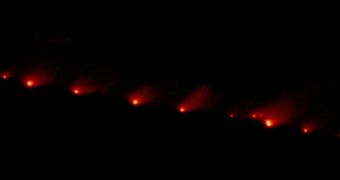The famous Shoemaker-Levy comet slammed into Jupiter in 1994. It represented the first direct observation of an instance in which two objects in the solar system collided with each other. The venerable Hubble space telescope, then in its early days, observed the impact, and sent back images of the disintegrating comet. Not 15 years later, in July 2009, an amateur astronomer observed that Jupiter had been impacted once more, this time by a space rock that left behind an Earth-sized scar. After analyzing this second collision, researchers now concluded that the likelihood of asteroid impacts within the solar system has increased by an order of magnitude, Technology Review reports.
Scientists at the University of the Basque Country in Bilbao, led by expert Agustin Sanchez-Lavega, now say that two possible sources for the 2009 impactor exist. They say that the space object, most likely an icy rock about 1 kilometer in diameter, came from either the Hilda asteroid group, or from the Jupiter Family group. The former is a group of space rocks in the main asteroid belt, while the latter is a group of comets at the fringes of the solar system. The issue here is that determining the frequency at which Jupiter gets hit by such objects is very difficult. Traces from impactors this size easily fade away, as evidenced by the fact that now, less than a year after the 2009 event, no signs of impact remain visible.
Using theoretical calculations founded on historical records and extrapolations, the group determined that Jupiter usually gets hit by various objects once every 350 years or so. But the recent instances, in which the gas giant took two blows in less than 15 years, may hint at a new trend. Sanchez-Lavega and his group now propose in a new paper published in the online journal arXiv, that Jupiter is now being hit once per decade, a drastic increase from before. The reason why this discovery is made only now is the fact that digital cameras and image processing technologies have only become available to amateur astronomers in recent times, over the past ten years.
The group failed to include in its paper details about how this finding affects our chances of getting hit by an asteroid or comet. Needless to say, this is of vital general importance, but indeed analyzing the risks we are subjected to is not all that simple. While some may argue that Jupiter is larger, and therefore more prone to attracting impactors, Earth is located closer to the Sun, in an area where comets swinging by from the outer solar system undergo the slingshot effect. Additionally, gas giants such as Jupiter can easily accelerate space rocks towards the inner planet, if they don't get hit themselves.

 14 DAY TRIAL //
14 DAY TRIAL //